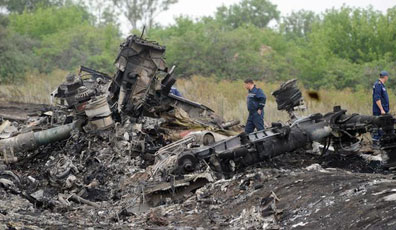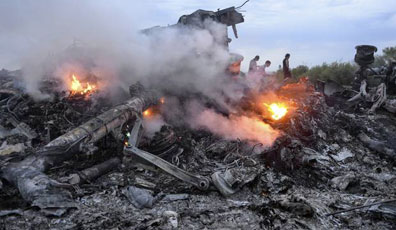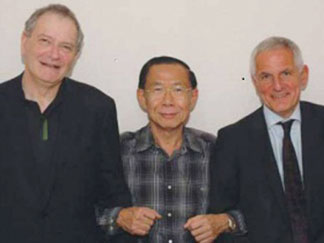MH17: Malaysia Airlines crash
 Tragic stories have been emerging of people who boarded the doomed
flight, including an entire Indonesian family, a nun and three young
children flying home with their grandfather. Tragic stories have been emerging of people who boarded the doomed
flight, including an entire Indonesian family, a nun and three young
children flying home with their grandfather.
All 298 passengers and crew died when the Boeing 777-200 crashed in
eastern Ukraine after apparently being shot down as it passed over the
war-torn country.
Glenn Thomas, 49, a media officer at the World Health Organisation
(WHO) was on his way to Australia with a delegation of scientists and
activists attending an international AIDS conference in Melbourne.
Fadela Chaib, a fellow WHO spokesman said: “Mr Thomas was on the flight
travelling to Australia to attend the AIDS conference in Australia.
Two Newcastle United fans travelling to see their team play in New
Zealand were also feared to be among the victims of the tragedy.
“Both were in attendance at Oldham on Tuesday, doing what they loved.
Our thoughts are with their friends, families and the many fans who knew
them by sight.
 Malaysia Airlines released a list of passengers’ nationalities,
including 189 Dutch, 27 Australians, 12 from Indonesians, 10 Britons,
four Belgians, four Germans, three Filipinos, one Canadian and one from
New Zealander. Malaysia Airlines released a list of passengers’ nationalities,
including 189 Dutch, 27 Australians, 12 from Indonesians, 10 Britons,
four Belgians, four Germans, three Filipinos, one Canadian and one from
New Zealander.
Few names have so far been confirmed but Malaysian media released
what appears to be a list with details of the 15 Malaysian crew members.
The eight women and seven men were aged between 26 and 53.
Sanjid Singh, an air steward, was only on the doomed jet because he
agreed to a rota swap, the Malaysian Insider reported. The paper said
that in a “bizarre twist of fate” Mr Singh's wife, also an air steward,
escaped death on flight MH370 131 days ago because she too organised a
shift change.
“We are heartbroken because he was our only son. What to do? What has
happened, has happened,” his father, Jijar Singh, said.
Names of some of the 80 children on board have been released,
including three young siblings from Perth in Australia.
Mo, Evie and Otis Maslin, aged 12, 10 and 8, were seen off by their
parents in Amsterdam before boarding the flight with their grandfather,
Melbourne's Herald Sun reported.
The Independent
********************
Double tragedy
An Australian family has tragically been hit by both Malaysia
Airlines tragedies, having now lost four members through flight MH370's
disappearance and flight MH17 being shot down over Ukraine, The
Independent reported.
Irene and George Burrows, from Bileola, Queensland, were still
mourning their son Rodney and his wife Mary after their plane vanished
without a trace over the southern Indian Ocean in March, and will now
have to grieve for their daughter Maree Rizk and her husband Albert who
were aboard MH17.
Flight MH17 was carrying at least 173 Dutch nationals, 44 Malaysians
(including 15 crew and two infants), 27 Australians, 12 Indonesians and
nine Britons. Other passengers came from Germany, Belgium, the
Philippines, Canada and New Zealand, BBC informed.
Other stories of passengers and crew emerging include a
Malaysia-Dutch family of five, a Dutch couple on their way to Bali, an
Australian pathologist and his wife returning from a European holiday,
as well as a Malaysian flight steward whose wife - who also works for
Malaysia Airlines - had narrowly escaped death when she pulled out of a
shift working on missing flight MH370.
********************
Maths student
Richard Mayne, 20, from Leicester, a maths and finance student at the
University of Leeds, was on his way to Perth in Australia. His father
Simon said today that he had chosen flight MH17 specifically because he
was diabetic and needed a stopover.
“He was on his way to Perth. When we were looking at flights
together, there was this one that stopped in Amsterdam and we thought it
would be perfect,” he said. “He was diabetic so we thought it would be a
good chance for him to do whatever he needed to do and maybe even go out
and have a ride on the bikes and see Amsterdam. He was really looking
forward to it. I took him to the airport at 3am myself, to fly to
Amsterdam.“When I first saw it on the news, my heart dropped. I just
thought, oh God, oh God - I couldn’t believe it. We were hoping and
praying he had fallen asleep at Amsterdam and missed his flight.
“You think you’ve got problems and them something like this happens
and it all just takes over.
I can’t even bring myself to look at a photograph of him. We are
beyond devastated. It is such a beautiful sunny day but our lives have
been torn apart.”
Mr Mayne leaves behind his parents and brothers Thomas, 24, William,
19, and sister Scarlett. According to his Facebook page, he was a keen
rugby player and recently raised more than £1,000 for Kidasha, which
supports disadvantaged children in Nepal.
********************
Why was a passenger plane flying over a conflict zone?
Loss of flight MH17 shows that the confidence in the immunity of
passenger planes in conflict zones was tragically misplaced
The Boeing 777 downed in Ukraine with the loss of 295 passengers was
flying just 1,000 feet above a “no-fly” zone covering the troubled
region. Malaysia Airlines flight MH17 was on a routine flight from
Amsterdam to Kuala Lumpur when it crashed, apparently after being hit by
a missile. The jet was travelling east across Ukraine along an airway
designated A87.
Eurocontrol, the co-ordination centre for air-traffic control in
Europe, said: “This route had been closed by the Ukrainian authorities
from ground to flight level 320 [32,000 feet] but was open at the level
at which the aircraft was flying.” The plane was flying at the lowest
permitted altitude over the area, flight level 330 [33,000 feet], when
it disappeared from the radar.
Since the crash, all the airspace of eastern Ukraine has been closed
to civil aircraft until further notice. Flight plans submitted by pilots
are automatically checked against closed areas of airspace. Eurocontrol
said: “All flight plans that are filed using these routes are now being
rejected.”
As the security situation in Ukraine deteriorated in April, the US
Federal Aviation Administration issued a warning to American pilots and
airlines operating in the region.
The “Notam” (Notice to Airmen) ordered “Exercise extreme caution due
to the continuing potential for instability”. Nevertheless, civil
aviation continued to fly over the conflict zone, along airways that
normally carry thousands of passengers on dozens of flights each day.
Since the news broke, many passengers have expressed astonishment
that commercial flights should be routed over a conflict zone such as
eastern Ukraine. One traveller, Nicholas Eeley, said: “I cannot believe
that civilian aircraft blithely overfly active battle zones. How bad
does it have to get to order a fly-round?”
Passenger planes have long been presumed to be safe from most
conflicts, for the practical reason that the weapons typically used on
the ground are far too primitive to reach an aircraft flying six miles
high.
The combatants in Ukraine have been thought unlikely to have the kind
of sophisticated weaponry that could reach a target at such an altitude.
Tony Wheeler, the founder of the travel guide publisher Lonely Planet
, recently blogged about a Qantas flight from Dubai to Heathrow over
northern Iraq: “Azwya, and Mosul, which we flew close by, have both been
flashpoints for the Isis takeover of parts of Iraq in recent weeks.
For any airline to lose two passenger aircraft within a few months is
extremely rare. For a pair of catastrophes to occur when the planes are
cruising normally at high altitude is unprecedented.
********************
World-renowned AIDS researcher on board
|

Professors David Cooper, Praphan Phanuphak and Joep Lange
|
Friends and colleagues of Prof Joep Lange, a world-renowned AIDS
researcher who was on board the stricken Malaysian flight, paid tribute
to his “tireless” efforts towards defeating HIV/AIDS .
Prof Lange and his wife Jacqueline van Tongeren were among about 100
passengers on flight MH17 who are believed to have been on their way to
the 20th International AIDS Conference in Melbourne, Australia.
Prof Lange, 59, was a clinical researcher from the Netherlands
specialising in HIV therapies and was a past president of the
International AIDS Society, which organised the Melbourne conference,
and had a distinguished track record in pioneering HIV treatments.
Prof David Cooper of the University of New South Wales, a close
colleague and friend of Prof Lange, issued a statement that confirmed
that the Dutch scientist and his wife were on board the Malaysian
aircraft.
“Joep had an absolute commitment to HIV treatment and care in Asia
and Africa. The joy in collaborating with Joep was that he would always
bring a fresh view, a unique take on things, and he never accepted that
something was impossible to achieve,” Prof Cooper said.
Francoise Barre-Sinoussi, who shared a Nobel Prize for discovering
HIV, said: “Joep was a great professional but more than that, he was a
wonderful human being.
It will be a terrible loss for us…I feel totally devastated.” Jeremy
Farrar, the director of the Wellcome Trust research charity led the
tributes from the UK: “Joep was a great clinical scientist, and a great
friend of the Wellcome Trust who has long been a valued adviser. He was
also a personal friend.
Andrew Phillips, professor of HIV epidemiology at UCL, said: “Joep
was a highly influential HIV researcher who made a huge contribution
over the past three decades and those of us working in the field who
knew him personally are feeling an enormous sense of loss of a much
valued colleague.” - The Independent
********************
Indonesian family
Yuli Hastini and John Paulisen, who lived in the Netherlands with
their two young children, were on their way to Indonesia where they
intended to visit Yuli’s mother’s grave, having missed her funeral last
year. Ms Hastini, 44, who worked for a pharmaceutical company, was
originally from Java but married Mr Paulisen, 47, a Dutchman. The couple
died alongside their two children, Arjuna, five and Sri, three.
********************
German intern
Fatima Dyczynski, 24, one of the four German victims, was on her way
to Australia where she had won an internship with IBM. Her parents Jezy
and Angela said they had spoken to their daughter on Skype shortly
before she boarded the aircraft. “At this moment we just don’t know what
to do,” Mrs Dyczynski said. “We believe she...I don’t know what we
believe. We are lost.”
********************
“Cossacks shot down the plane”
Kiev and Moscow have blamed each other for the Malaysian Airlines
disaster. Putin ordered Russian military and civilian agencies to
co-operate with any investigation but, according to a Kremlin statement,
said the “state over whose territory this occurred bears responsibility
for this awful tragedy.”
The Ukrainian foreign minister, Pavlo Klimkin, said on Friday there
was no chance the missile was of Ukrainian military origin.
Russia's Channel One avoided speculation of who might have been
behind the plane crash in its first bulletins on the subject, while the
Life News, said it was likely to have been brought down by Ukrainian
fire, claiming that the rebels did not have any missile systems with the
capacity to down a plane at that altitude.
However a report on the website of Russian state television from late
June described how the rebels in Donetsk had taken control of a
Ukrainian missile defence facility that was equipped with Buk systems.
On Thursday afternoon a social media site attributed to Igor Strelkov,
a Russian citizen who has emerged as the commander of rebel forces in
Donetsk, announced that the rebels had shot down an An-26 Ukrainian
transport plane, and also that there was “information about a second
plane”. The post was later removed.Audio was circulated on social media,
apparently released by Ukrainian security services, purporting to be an
intercepted conversation of pro-Russia rebels confirming they had shot
down a civilian jet. The conversation is apparently between a group
leader and his superior and suggests that they initially thought they
had brought down a military aircraft but later realised their error.
The group leader, “Demon”, tells his boss: “A plane has just been
shot down. [It was] ‘Miner's’ group. It crashed outside Enakievo. Our
men went to search for and photograph it. It's smouldering.”
After his men apparently inspect the crash site, Demon reports back.
“Cossacks from the Chernunkhino checkpoint shot down the plane. The
plane disintegrated in mid-air … they found the first body. It's a
civilian.” He carries on: “I mean. It's definitely a civilian aircraft.”
His superior, nicknamed “Greek”, asks him: “Were there many people?”
Demon replies: “The debris rained right into the yards.”
Greek asks: “What's the aircraft?” and is told: “I haven't figured it
out yet. I haven't reached the main section. I only looked at where the
bodies began to fall. There are remains of chair mounts, the chairs, the
bodies.”
Greek asks: “Any weapons there?” and Demon says: “None at all.
Civilian things, medical stuff, towels, toilet paper.”
“Any documents?” asks Greek, and Demon, perhaps realising what has
just happened, replies: “Yes, an Indonesian student from Thomson
university [in the US].”
- The Guardian
********************
Don’t blame Malaysia Airlines
Almost as soon as the news broke about the shooting down of a
Malaysia Airlines flight over Ukraine, in which all 298 passengers and
crew members were killed, people began to ask: What was a commercial
aircraft doing over a conflict zone in the first place? Was this
disaster somehow the airline’s fault?
The answer is no - but to understand why, you have to look at the
complex realities of modern commercial aviation.
Malaysia Airlines, already world famous because of the still-missing
flight MH370, appears to have been following all normal safety rules.
And the rules governing airline flights over danger zones, including
Ukraine, reflect the balance between the risks inherent in any flight
and the efficiency on which the world airline system depends. In
principle, every airline flight can minimise travel time, emissions,
fuel burn and overall cost by taking the most direct point-to-point
route. In practice, everything about commercial aviation involves making
adjustments to that ideal direct routing, all of which is managed by the
international air control system.
Before a flight, an airliner’s crew coordinates with company
dispatchers about any necessary deviations from the desired route.
During flight, they make further adjustments - to avoid
thunderstorms, for example. They often request route shifts to the north
or south, or changes of altitude, to find smoother air or more
favourable winds.
The Federal Aviation Administration, which has jurisdiction over
American pilots and airlines, and its international counterparts
maintain constantly updated “special notice” sites of airspace to avoid.
The administration’s current list urges great caution for flights
over hot spots like Yemen, North Korea and Syria, and it prohibits
low-level flights (below 20,000 feet) over some sites in Somalia and
Iraq.
- NYT
|

